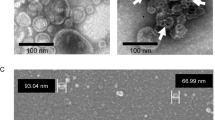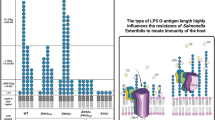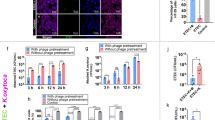Abstract
Glycosaminoglycans (GAGs) are linear heteropolysaccharides consisting of repeated disaccharide units that are variablyN- andO-sulfated. Due to this heterogeneity, GAGs possess a high amount of structural information. Linked to a protein core to form a proteoglycan, GAGs are present on the surface of probably all mammalian tissues. During the recent years, a number of pathogens ranging from viruses to protozoans were found to interact specifically with cell surface GAGs to recognize and bind to their target cells. This review is intended to give a short overview over protein-GAG interaction under the aspects of infection.
Similar content being viewed by others
References
Baba M, Pauwels R, Balzarini J, Arnout J, Desmyter J, De Clerq E (1988) Mechanism of inhibitory effect of dextran sulfate and heparin on replication of human immunodeficiency virus in vitro. Proc Natl Acad Sci USA 85:6132–6136
Batinic D, Robey FA (1992) The V3 region of the envelope glycoprotein of human immunodeficiency virus type 1 binds sulfated polysaccharides and CD4-derived synthetic peptides. J Biol Chem 267:6664–6671
Bendheim PE, Barry RA, DeArmond SJ, Stites DP, Pruisiner SB (1984) Antibodies to scrapie prion protein. Nature 310:418–421
Bergey EJ, Stinson MW (1988) Heparin-inhibitable basement membrane-binding protein ofStreptococcus pyogenes. Infect Immun 56:1715–1721
Brener Z (1973) The biology ofTrypanosoma cruzi. Annu Rev Microbiol 27:347–381
Callahan LN, Phelan M, Mallinson M, Norcross MA (1991) Dextran sulfate blocks antibody binding to the principal neutralizing domain of human immunodeficiency virus type I without interfering with gp120-CD4 interactions. J Virol 65:1543–1550
Cardin AD, Taylor DL, Krstenansky JL, Tyms AS, Jackson RL (1989) A heparin which binds to the envelope glycoprotein gp120 inhibits human immunodeficiency virus replication. Trans Assoc Am Physicians CII:101–109
Cardin AD, Weintraub HJR (1989) Molecular modeling of protein-glycosaminoglycan interactions. Arteriosclerosis 9:21–32
Caughey B (1994) Protease-resistant PrP accumulation and scrapie agent replication: a role for sulphated glycosaminoglycans? Biochem Soc Trans 22:163–167
Caughey B, Race RE (1992) Potent inhibition of scrapie-associated PrP accumulation by Congo red. J Neurochem 59:768–771
Caughey B, Raymond GJ (1993) Sulfated polyanion inhibition of scrapie-associated PrP accumulation in cultured cells. J Virol 67:634–650
Caughey B, Ernst D, Race RE (1993) Conge red inhibition of scrapie agent replication. J Virol 67:6270–6272
Caughey B, Brown K, Raymond GJ, Katzenstein GE, Thresher W (1994) Binding of the protease-sensitive form of prion protein PrP to sulfated glycosaminoglycan and congo red. J Virol 68:2135–2141
Cerami C, Frevert U, Sinnis P, Takacs B, Clavijo P, Santos MJ, Nussenzweig V (1992) The basolateral domain of the hepatocyte plasma membrane bears receptors for the circumsporozoite protein ofPlasmodium falciparum sporozoites. Cell 70:1021–1033
Cohen JI, Seidel KE (1994) Absence of varicella-zoster virus (VZV) glycoprotein v does not alter growth of VZV in vitro or sensitivity to heparin. J Gen Virol 75:3087–3093
Compton T, Nowlin DM, Cooper NL (1993) Initiation of human cytomegalovirus infection requires initial interaction with cell surface heparan sulfate. Virology 193:834–841
Dalgleish AG, Beverley PCL, Clapham PR, Crawford DH, Greaves MF, Weiss RA (1984) CD4 (T4) antigen is an essential component of the receptor for the AIDS retrovirus. Nature 312:763–767
Flynn SJ, Ryan P (1995) A heterologous heparin-binding domain can promote functional attachment of a Pseudorabies virus gC mutant to cell surfaces. J Virol 69:834–839
Flynn SJ, Burgett BL, Stein DS, Wilkinson KS, Ryan P (1993) The amino-terminal one-third of pseudorabies virus glycoprotein gIII contains a functional attachment domain, but this domain is not required for the efficient penetration of Vero cells. J Virol 67:2646–2654
Fraser PE, Nguyen JT, Chin DT, Kirschner DA (1992) Effects of sulfate ions on Alzheimer β/A4 peptide assemblies: implications for amyloid fibril-proteoglycan interactions. J Neurochem 59:1531–1540
Gerok W, Kottgen E, Reutter W (1982) Glycoproteins on hepatocytic surfaces. Proc Liver Dis 7:87–107
Glenner GG, Wong CW (1984) Alzheimer's disease: initial report of the purification and characterization of a novel cerebrovascular amyloid protein. Biochem Biophys Res Commun 120:885–890
Glenner GG, Wong CW (1984) Alzheimer's disease and Down's syndrome: sharing a unique cerebrovascular amyloid fibril protein. Biochem Biophys Res Commun 120:1131–1135
Hannah JH, Menozzi FD, Renauld G, Locht C, Brennan MJ (1994) Sulfated glycoconjugate receptors for theBordetella pertussis adhesin filamentous hemagglutinin (FHA) and mapping of the heparin-binding domain on FHA. Infect Immun 62:5010–5019
Haywood AM (1994) Virus receptors: binding, adhesion strengthening, and changes in viral structure. Minireview. J Virol 68:1–5
Herold BC, WuDunn D, Soltys N, Spear PG (1991) Glycoprotein C of herpes simplex virus type 1 plays a principal role in the adsorption of virus to cells and in infectivity. J Virol 65: 1090–1098
Herold BC, Visalli RJ, Susmarski N, Brandt CR, Spear PC (1994) Glycoprotein C-independent binding of herpes simplex virus to cells requires cell surface heparan sulphate and glycoprotein B J Gen Virol 75:1211–1222
Hinkes MT, Bernfield M (1993) Syndecan. In: Kreis T, Vale R (eds) Guidebook to the extracellular matrix and adhesion proteins. Oxford University Press, New York, pp 91–93
Holt GD, Pangburn MK, Ginsburg V (1989) Properdin binds to sulfatide [Gal(3-SO4)β1-1Cer] and has a sequence homology with other proteins that bind sulfated glycoconjugates. J Biol Chem 265:2852–2855
Ida H, Kurata A, Eguchi K, Yamashita I, Nakashima M, Sakai M, Kawabe Y, Nakamura T, Nagataki S (1994) Mechanism of inhibitory effect of dextran sulfate and heparin on human T-cell lymphotrophic virus type I (HTLV-I)-induced syncytium formation in vitro: role of cell-to-cell contact. Antiviral Res 23: 143–159
Jackson RL, Busch SJ, Cardin AD (1991) Glycosaminoglycans molecular properties, protein interactions, and role in physiological processes. Physiol Rev 71:481–539
Johnson DC, Ligas MW (1988) Herpes simplex viruses lacking glycoprotein D are unable to inhibit virus penetration: quantitative evidence for virus-specific cell surface receptors. J Virol 62:4605–4612
Karger A, Mettenleiter TC (1993) Glycoproteins gIII and gp50 play dominant roles in the biphasic attachment of pseudorabies virus. Virology 194:654–664
Kiyokawa T, Yoshikura H, Hattori S, Seiki M, Yoshida M (1984) Envelope proteins in human T-cell leukemia virus: expression inEscherichia coli and its application to studies of env gene functions. Proc Natl Acad Sci USA 81:6202–6206
Klatzmann D, Champagne E, Chamaret S, Grust J, Guetard D, Hercend T, Gluckman J-C, Montagnier L (1984) T-lymphocyte T4 molecule behaves as the receptor for human retrovirus LAV. Nature 312:767–768
Kocisko DA, Come JH, Priola SA, Chesebro B, Raymond GJ, Lansbury PT, Caughey B (1994) Cell-free formation of protease-resistant prion protein. Nature 370:471–474
Kosik KS, Joachim CL, Selkoe DJ (1986) Microtubule-associated protein tau (τ) is a major antigenic component of paired filaments in Alzheimer's disease. Proc Natl Acad Sci USA 83: 4044–4048
Kühn JE, Kramer MD, Willenbacher W, Wieland U, Lorentzen EU, Braun RW (1990) Identification of herpes simplex virus type 1 glycoproteins interacting with the cell surface. J Virol 64:2491–2497
Lander AD (1993) Proteoglycans. In: Kreis T, Vale R (eds) Guidebook to the extracellular matrix and adhesion proteins. Oxford University Press, New York, pp 12–16
Lee MV-Y, Balin BJ, Otvos L Jr, Trojanowski JQ (1991) A68: a major subunit of paired helical filaments and derived forms of normal tau. Science 251:675–678
Liang OD, Ascencio F, Fransson LA, Wadstrom T (1992) Binding of heparan sulfate toStaphylococcus aureus. Infect Immun 60:899–906
Liang X, Babiuk LA, Zamb TJ (1993) Mapping of heparin-binding structures on bovine herpesvirus 1 and pseudorabies virus glycoprotein gIII glycoproteins. Virology 194:233–243
Love DC, Esko JD, Mosser DM (1993) A heparin-binding activity on Leishmania amastigotes which mediates adhesion to cellular proteoglycans. J Cell Biol 123:759–766
Lüscher-Mattli M, Glück R, Kempf C, Zanoni-Grassi M (1993) A comparative study of the effect of dextran sulfate on the fusion and the in vitro replication of influenza A and B, Semliki Forest, vesicular stomatitis, rabies, Sendai, and mumps virus. Arch Virol 130:317–326
Menozzi FD, Gantiez C, Locht C (1991) Interaction of theBordetella pertussis filamentous hemagglutin with heparin. FEMS Microbiol Lett 78:59–64
Mettenleiter TC, Zsak L, Zuckermann F, Sugg N, Kern H, Ben-Porat T (1990) Interaction of glycoprotein gIII with a cellular heparinlike substance mediates adsorption of pseudorabies virus. J Virol 64:278–286
Mitsuya H, Looney DJ, Kuno S, Ueno R, Wong-Staal F, Broder S (1988) Dextran sulfate suppression of viruses in the HIV family: inhibition of virion binding to CD4+ cells. Science 240:646–649
Moulder JW (1991) Interaction of chlamydiae and host cells in vitro. Microbiol Rev 55:143–190
Nahmias AJ, Kibrick S (1964) Inhibitory effect of heparin on herpes simplex virus. J Bacteriol 87:1060–1066
Narindrasorasak S, Lowery D, Gonzalez-DeWitt P, Poorman RA, Greenberg B, Kililevsky R (1991) High affinity interactions between the Alzheimer's beta-amyooid precursor proteins and the basement membrane form of heparan sulfate proteoglycan. J Biol Chem 266:12878–12883
Neyts J, Snoeck R, Schols D, Balzarini J, Esko JD, Schepdael A van De Clerq E (1992) Sulfated polymers inhibit the interaction of human cytomegalovirus with cell surface heparan sulfate. Virology 189:48–58
Okada T, Patterson BK, Otto PA, Gurney ME (1994) HIV type 1 infection of CD4+ T cells depends critically on basic amino acid residues in the V3 domain of envelope glycoprotein 120. AIDS Res Hum Retroviruses 10:803–811
Okazaki K, Matsuzaki T, Sugahara Y, Okada J, Hasebe M, Iwamura Y, Ohnishi M, Kanno T, Shimizu M, Honda E, Kono Y (1991) BHV-1 adsorption is mediated by the interaction of glycoprotein III with heparinlike moiety on the cell surface. Virology 181:666–670
Oohira A, Katoh-Semba R, Watanabe E, Matsui F (1994) Brain development and multiple molecular species of proteoglycan. Neurosci Res 20:195–207
Ortega-Barria E, Pereira MEA (1991) A novelT. cruzi heparin-binding protein promotes fibroblast adhesion and penetration of engineered bacteria and trypanosomes into mammalian cells. Cell 67:411–421
Osame M, Usuku K, Izumo S, Ijichi N, Amitani H, Igata A, Matsumoto M, Tara M (1986) HTLV-I associated myelopathy, a new clinical entity. Lancet I:1031–1032
Pancake SJ, Holt GD, Mellouk S, Hoffman SL (1992) Malaria sporozoites and circumsporozoite proteins bind specifically to sulfated glycoconjugates. J Cell Biol 117:1351–1357
Poiesz BJ, Ruscetti FW, Gazdar AF, Bunn PA, Minna JD, Gallo RC (1980) Detection and isolation of type C retrovirus particles from fresh and cultured lymphocytes of a patient with cutaneous T-cell lymphoma. Proc Natl Acad Sci USA 77:7415–7419
Prusiner SB (1994) Biology and genetics of prion diseases. Annu Rev Microbiol 48:655–686
Sattenau QJ, Weiss RA (1988) The CD4 antigen: physiological ligand and HIV receptor. Cell 52:631–633
Sawitzky D, Hampl H, Habermehl K-O (1990) Comparison of heparin-sensitive attachment of pseudorabies virus and herpes simplex virus type 1 and identification of heparin-binding PrV-glycoproteins. J Gen Virol 71:1221–1225
Sawitzky D, Hampl H, Habermehl K-O (1990) Entry of pseudorabies virus into CHO cells is blocked at the level of penetration. Arch Virol 115:309–316
Sawitzky D, Voigt A, Habermehl K-O (1993) A peptide-model for the heparin-binding property of pseudorabies virus glycoprotein III. Med Microbiol Immunol 182:285–292
Schachter J (1988) Overview of human diseases. In Barron AL (ed) Microbiology of Chlamydia. CRC Press, Boca Raton, pp 153–165
Schols D, Pauwels R, Desmyter J, De Clerq E (1990) Dextran sulfate and other polyanionic anti-HIV compounds specifically interact with the viral gp120 glycoprotein expressed by T-cells persistently infected with HIV. Virology 175:556–561
Snow AD, Wight TN (1989) Proteoglycans in the pathogenesis of Alzheimer's disease and other amyloidoses. Neurobiol Aging 10:481–497
Snow AD, Sekiguchi R, Nochlin D, Fraser P, Kimata K, Mizutani A, Arai M, Schreier WA, Morgan DG (1994) An important role of heparin sulfate proteoglycan (Perlecan) in a model system for the deposition and persistence of fibrillar A beta-amyloid in rat brain. Neuron 12:219–234
Taylor HP, Cooper NR (1990) The human cytomegalovirus receptor on fibroblasts is a 30-kilodalton membrane protein. J Virol 64:2484–2490
Trybala E, Bergström T, Svennerholm B, Jeansson S, Glorioso JC, Olofsson S (1994) Localization of a functional site on herpes simplex virus type 1 glycoprotein C involved in binding to cell surface heparan sulfate. J Gen Virol 75:743–752
Ueno R, Kuno S (1987) Dextran sulphate, a potent anti-HIV agent in vitro having synergism with zidovudine. Lancet I:1379
Vaheri A (1964) heparin and related polyionic substances as virus inhibitors. Acta Pathol Microbiol Scand [Suppl] 171:7–97
Vaheri A, Cantell K (1963) The effect of heparin on herpes simplex virus. Virology 21:661–662
Weiss RA, Clapham P, Nagy K, Hoshino H (1985) Envelope properties of human T-cell leukemia viruses. Curr Top Microbiol Immunol 115:235–246
Witvrouw M, Desmyter J, De Clercq (1995) Antiviral portrait series. 4. Polysulfates as inhibitors of HIV and other enveloped viruses. Antiviral Chem Chemother 5:345–359
WuDunn D, Spear PG (1989) Initial interaction of herpes simplex virus with cells is binding to heparan sulfate. J Virol 63:52–58
Wyler DJ (1992) Plasmodium and Babesia. In: Gorbach SL, Bartlett JG, Blacklow NR (eds) Infectious diseases. Saunders, Philadelphia, pp 1967–1978
Wyrick PB, Choong J, Davis CH, Knight ST, Royal MO, Maslow AS, Bagnell CR (1989) Entry of genital Chlamydia trachomatis into polarized human epithelial cells. Infect Immun 57:2378–2389
Zhang JP, Stephens RS (1992) Mechanism ofC. trachomatis attachment to eukaryotic host cells. Cell 69:861–869
Author information
Authors and Affiliations
Rights and permissions
About this article
Cite this article
Sawitzky, D. Protein-glycosaminoglycan interactions: infectiological aspects. Med Microbiol Immunol 184, 155–161 (1996). https://doi.org/10.1007/BF02456129
Received:
Issue Date:
DOI: https://doi.org/10.1007/BF02456129




